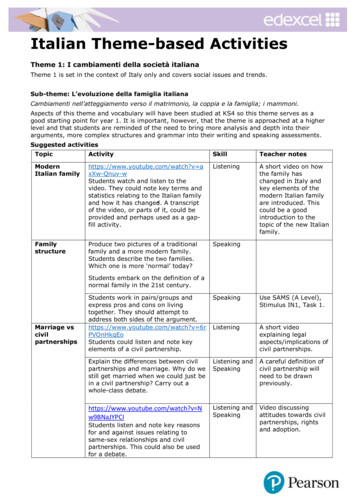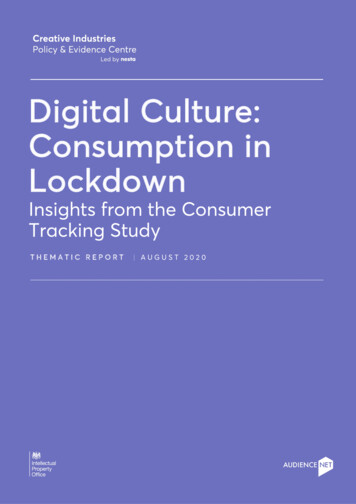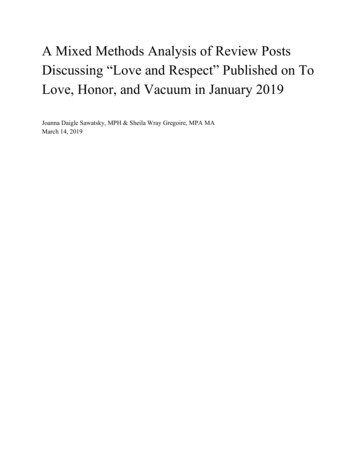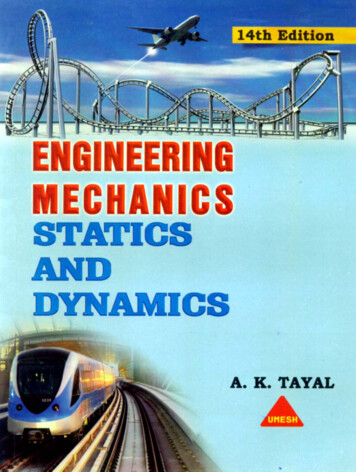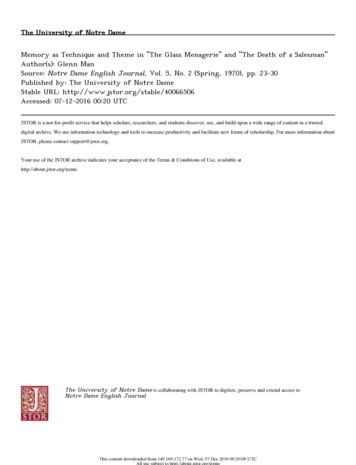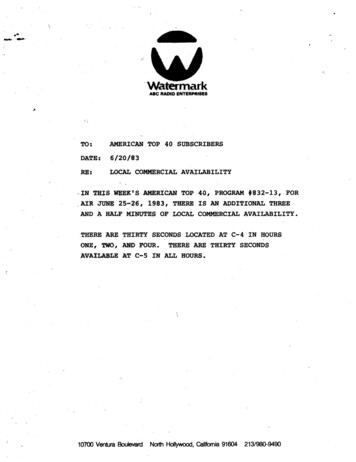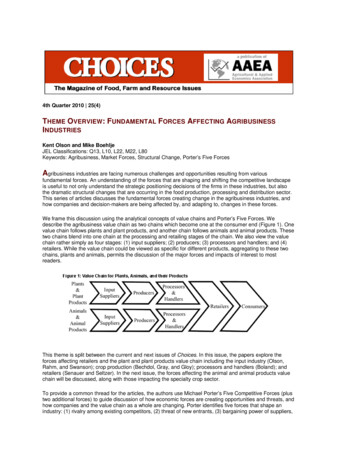
Transcription
4th Quarter 2010 25(4)THEME OVERVIEW: FUNDAMENTAL FORCES AFFECTING AGRIBUSINESSINDUSTRIESKent Olson and Mike BoehljeJEL Classifications: Q13, L10, L22, M22, L80Keywords: Agribusiness, Market Forces, Structural Change, Porter’s Five ForcesAgribusiness industries are facing numerous challenges and opportunities resulting from variousfundamental forces. An understanding of the forces that are shaping and shifting the competitive landscapeis useful to not only understand the strategic positioning decisions of the firms in these industries, but alsothe dramatic structural changes that are occurring in the food production, processing and distribution sector.This series of articles discusses the fundamental forces creating change in the agribusiness industries, andhow companies and decision-makers are being affected by, and adapting to, changes in these forces.We frame this discussion using the analytical concepts of value chains and Porter’s Five Forces. Wedescribe the agribusiness value chain as two chains which become one at the consumer end (Figure 1). Onevalue chain follows plants and plant products, and another chain follows animals and animal products. Thesetwo chains blend into one chain at the processing and retailing stages of the chain. We also view the valuechain rather simply as four stages: (1) input suppliers; (2) producers; (3) processors and handlers; and (4)retailers. While the value chain could be viewed as specific for different products, aggregating to these twochains, plants and animals, permits the discussion of the major forces and impacts of interest to mostreaders.This theme is split between the current and next issues of Choices. In this issue, the papers explore theforces affecting retailers and the plant and plant products value chain including the input industry (Olson,Rahm, and Swanson); crop production (Bechdol, Gray, and Gloy); processors and handlers (Boland); andretailers (Senauer and Seltzer). In the next issue, the forces affecting the animal and animal products valuechain will be discussed, along with those impacting the specialty crop sector.To provide a common thread for the articles, the authors use Michael Porter’s Five Competitive Forces (plustwo additional forces) to guide discussion of how economic forces are creating opportunities and threats, andhow companies and the value chain as a whole are changing. Porter identifies five forces that shape anindustry: (1) rivalry among existing competitors, (2) threat of new entrants, (3) bargaining power of suppliers,
(4) bargaining power of buyers, and (5) the threat of substitute products (Porter, 2008). Two additional forcesaffecting competition have been described as: (6) technology and (7) other drivers of change (Boehlje andHofing, 2005). These last two forces introduce an external dynamic to Porter’s forces. These seven forcesare described briefly below.Rivalry among Established FirmsThe level of rivalry within an industry can depend, in large part, on the number of firms, demand conditions,and exit barriers. Due to the number of firms involved, many agricultural industries are often described asperfectly competitive—as opposed to monopolistic competition, oligopoly, or monopoly. However,government regulation and intervention, as well as the size and dominance of a few firms, can providedifferent degrees of perfect competition.Rivalry also varies depending on whether demand is growing with new customers, growing with existingcustomers, stagnant, or declining. With growing demand and new customers, firms can find customers moreeasily and expand production. With only existing customers, firms will have to compete more on price andnonprice factors to capture customers from competitors and keep current customers. Rivalry is greatest whendemand is declining as firms vie for a share of a shrinking market.Higher exit barriers can increase rivalry and competitive pressures. This can happen when profitability is lowfor an industry, but firms are unable to exit—or exit quickly—due to investments in specialized assets, highexit/shut-down costs, emotional attachments to an industry, or contractual or other relationships betweenfirms.Threat of Entry by Potential CompetitorsPotential competitors may be across the road, across the nation or across the ocean. The threat of entrydepends on the height of barriers to entry. These barriers include: the extent to which established firms havescale economies, the extent to which established firms enjoy a market or cost advantage over potentialentrants, high capital requirements for new entrants, the extent to which established firms have better accessto distribution channels for inputs and outputs, the extent to which government regulations restrict entry, andthe extent to which established firms have brand name loyalty with customers.Bargaining Power of SuppliersSuppliers are a threat to firm and industry profitability when they are able to increase the price of theirproduct or affect the quantity and quality of the products supplied. Fewer suppliers mean they have greaterpower. Improved communication technology has taken away the power of many local suppliers. The recentmergers of suppliers and the consolidation of input technologies, such as seeds and pesticides, haveincreased the suppliers’ bargaining power with farmer-customers, as well as changed the competitivepressures within the input industries. Suppliers have power if they are more concentrated than their buyers,do not receive a high percentage of their revenues from one industry, have customers with high switchingcosts to change suppliers, have a differentiated product, have a product with no substitutes, through eitherreal differences or patent protection, or could forward integrate into additional stages in the value chain.Bargaining Power of BuyersThe number of buyers has a very large impact on how the market works. Fewer buyers mean they havegreater power. If sellers cannot easily ship their products to other markets, or they do not have priceinformation from other markets, a few local buyers can have considerable power even though the totalnumber of buyers is large in the broader market. The increasing use of contracts can increase the power ofthe buyer through controlling the amount of price information in the marketplace. In ways similar to suppliers,buyers have power if they are few in number or a few buy a large percentage of the product in the market,products are undifferentiated commodities, or buyers could integrate backwards in the value chain. Buyerswill also bargain harder if the product constitutes a major portion of the buyer’s total costs, or if the producthas little effect on the quality of the buyer’s product or other costs.
Substitute Products and ServicesSubstitute products limit the price that producers can seek or ask for without losing customers to thosesubstitutes. Competitive pressure comes from the attempts of the producers of the substitutes to win buyersto their products. The advertising campaigns of the pork, beef, and poultry industries are an obvious exampleof the competitive pressures due to substitute animal protein products; each industry feels forced to advertiseto keep customers, and cannot charge as much as they would like without pushing their customers intobuying other products.TechnologyChanges in technology can have a large impact on the production of and demand for a service or product ofa firm. The risk from technological change depends on the size and the role of technology in the industry, aswell as the speed of technical change. Advances in technology can be disruptive; they can cause leaps thatleave users of old technology far behind. The expected lifespan or change in technology can put businesseson the treadmill of continually having to retool to keep up with their competitors. New technology can alter notonly the efficiency and cost of the production process, but the actual products and services offered anddemanded by others in the value chain. New chains may be created due to a new technology incommunication as well as in products and services.Other Drivers of ChangeOther drivers of change include changes in government policy and regulations, changes in international tradeagreements, demographic changes, and other factors not included in the first six forces. Competitivepressure comes from differing abilities of firms to respond and adapt to these changes. The impact of theseforces depends on the scope of the change, the speed at which change is anticipated or actually felt, and thedepth and breadth of the responses needed to adapt to these changes.Figure 2 provides a pictorial summary of the modified Five Forces framework. This framework was used byeach of the authors of the articles for this theme to analyze the challenges, opportunities and changes for thevarious stages of the agribusiness value chain.
For More InformationBoehlje, M., and Hofing S. (2005). Managing and Monitoring a Growing Production Agriculture Firm: Part II.Centrec Consulting Group, LLC., Savoy, Illinois, available 20presentation.pdf.Porter, Michael E. (2008). The Five Competitive Forces that Shape Strategy. Harvard Business Review.(January 2008), p. 79-93.Kent D. Olson (kdolson@umn.edu) is Professor, Department of Applied Economics, University of Minnesota,St. Paul, Minnesota. Michael Boehlje (boehljem@purdue.edu) is Distinguished Professor, Department ofAgricultural Economics, Purdue University, West Lafayette, Indiana. 1999-2010 Choices. All rights reserved. Articles may be reproduced or electronically distributed as long asattribution to Choices and the Agricultural & Applied Economics Association is maintained.
4th Quarter 2010 25(4)M ARKET FORCES AND CHANGES IN THE PLANT INPUT SUPPLY INDUSTRYKent Olson, Michael Rahm, and Michael SwansonJEL Classifications: Q13, L10, L22, M22, L80Keywords: Agribusiness, Input Supply Industry, Fertilizer, Plant Nutrients, Seed, Capital, Market Forces,Structural Change, Porter’s Five ForcesThe plant input supply industry is composed of many diverse segments and companies that supply farmerswith seed, nutrients, pesticides, machinery, capital, labor, and many other inputs. These segments,companies and their markets are both domestic and international, so any review of market forces needs tohave a global focus in how they will likely continue to evolve into the future. Since we do not have space inthis article to cover every segment of this large industry in detail, we explore the impact of the major forcesdriving change using examples from the different segments and companies of the plant input industry.Rivalry among Existing CompetitorsThe plant input industry has seen a dramatic reduction in the number of competitors. But the lower absolutenumber of suppliers has not diminished the price competition between industry players. Most of the plantinput suppliers have high fixed cost structures in land, capital equipment, and significant permitting, approval,and regulatory costs. This gives existing competitors a strong economic incentive to strive for market sharemore aggressively than if they had low fixed costs. Each additional percent of the market allows them tospread their fixed costs and brings a better net margin. Given the regulatory and technological requirementsto stay competitive in these sectors, the high fixed cost aspect of market share competitiveness will onlycontinue to be a prominent feature.Another aspect of rivalry is market segmentation. Within each plant input sector, similar aspects ofsegmentation make internal rivalry a complicated dynamic. For example, in the agricultural finance sector, alimited number of firms have the capital and expertise to make loans in excess of 10 million, but literallythousands of local banks and credit unions can make loans under 10 million. Even though we might expectit due to the fewer number of firms, competition is not diminished even in the large loan segment, due toelectronic communication making market information available to borrowers and the ability and willingness oflarge borrowers to seek better terms beyond traditional geographic areas.In the case of plant nutrients, there are three distinct markets and industries: nitrogen (N), phosphate (P) andpotash (K). While there are common demand drivers for these nutrients such as grain prices, there aredifferent supply drivers. Each primary nutrient requires different natural resources as well as different miningand processing technologies. These natural resources are located in different parts of the world. In the caseof nitrogen, regions with low cost natural gas such as the Mideast, Russia and the Caribbean Basin are keyproducers and exporters. In the case of phosphate, regions with rich deposits of phosphate rock and accessto low cost sulphur and ammonia are the main producers. These regions include Morocco and a few otherNorth African countries; the United States; China; Russia; Israel and Jordan. In the case of potash, only 12countries mine this mineral; Canada, Russia/Belarus, Germany, Israel and Jordan are the largest producers.Despite fewer producers today compared to a couple of decades ago, these are large global markets andprices of crop nutrients in the middle of Illinois are impacted by fundamental developments from around theworld. For example, nitrogen and phosphate trade account for about 40% of global use (Table 1). Potash
trade—excluding the large movement from Canada to the USA—accounts for approximately 70% of globalpotash use. These percentages compare to 13% for the major grains. Even though these large globalmarkets are served by fewer companies today, industry concentration, as measured by the HerfindahlHerschman Index (HHI), is low for each nutrient (Table 2). Following the procedures described by the U.S.Department of Justice and the Federal Trade Commission, HHI is the sum of the squared market shares byfirm with a market categorized as “unconcentrated” if the HHI is less than 1500, “moderately concentrated”for an HHI between 1500 and 2500, and “highly concentrated” if the HHI exceeds 2500.Firms throughout the entire supply chain compete on the basis of price and cost efficiency. A good exampleis the proliferation of unit train movements of fertilizer to ‘big barn’ retail warehouses primarily in the Midwest.
Today, nearly all of the phosphate shipped by Mosaic—the world's leading producer and marketer ofconcentrated phosphate and potash—via rail from central Florida to domestic customers moves in 65 to 80car unit trains with ‘turns’ as low as 12 days. That was not the case 10 years ago. More and more retailersare investing in large warehouses (15,000 tons) capable of unloading unit trains in order to capturesignificant freight savings and compete with the dealer down the road or, more likely, in the next county.The farm machinery and equipment manufacturing industry (North American Industry Classification System(NAICS) code 333111) is obviously a key input industry in the plant and plant product chain and faces manyof the same forces described in this article for other input industries. While there have been mergers andacquisitions within this industry, they have not been as substantive or pervasive as in the plant nutrient andthe seed/biotech/crop protection segments. Concentration is moderate and has decreased very slightly asseen in the HHI for the 50 largest companies which totaled 1,707 in the 1997 Economic Census of the UnitedStates and 1,657 in the 2002 census. This slight decrease in HHI is contradicted by an increase in the marketshare of the four largest companies, as measured by the value of shipments, which increased from 53% in1997 to 58% in 2002; market share for the eight largest increased from 60% to 65%.Acquisition by and purchase of competitors is a highly cyclical activity that is exacerbated by fluctuatingcurrency exchange rates and international financing factors. With the U.S. dollar near all-time lows for itsbroad-weighted exchange rate, the value of U.S. agribusiness assets—including all companies in the inputsupply industry—has been very attractive to foreign firms that have access to capital in non-dollar markets.Consequently, the acquisition of U.S. agribusinesses by foreign companies has increased dramaticallyrecently. This increasing globalization of input segments increases the volatility of rivalry by introducingcompeting firms from other geographic areas.Another important point is that there is a big difference between industry consolidation and the loss of asegment’s competitive advantage. The U.S. nitrogen and phosphate industries are good examples. The U.S.nitrogen industry is about 60% of the size it was 15 years ago. The U.S. industry simply could not competewith foreign producers when domestic natural gas prices began to increase relative to values in other regionsearly last decade. Strong global demand growth coupled with lower relative natural gas prices resulting fromthe development of large shale gas reserves domestically has stabilized and may even breathe new life intothe U.S. nitrogen industry. Nevertheless, the United States now imports roughly one-half of its nitrogenneeds.In the case of phosphate, some firms depleted their rock reserves and went out of business and others didnot invest in new mine development because returns were so low during the first half of the last decade. Thelargest U.S. phosphate producer, IMC Global, merged with the Crop Nutrition business of Cargill to formMosaic in 2004. U.S. phosphate rock production today is about one-half of its peak a dozen years ago. Thecompetitive advantage of U.S. phosphate producers has eroded over time due to the higher costs ofdeveloping, extracting and processing lower quality secondary and tertiary reserves, as well as complyingwith more restrictive environmental regulations. Needless to say, the United States plays a much smaller rolein the global phosphate market today than it did a decade ago.Threat of New EntrantsPotential entrants into the plant input sector are both domestic and international, with the latter being a largerthreat. The entry of a new local competitor is a small risk in most plant input sectors. In the rapidly changingdynamics of plant inputs, foreign competitors can be enabled by governmental financing without regard toshort-term or even intermediate profitability of the entrant. The entrance of Chinese glyphosate producers isa very clear example. All of the new producers emerged as a result of capacity added to existing Chinesepetrochemical facilities. Each of these new producers saw a chance to increase local employment and exportopportunities. It seems unlikely that they engaged in a market analysis that took into consideration a longterm profit potential. Increasingly, growing economies such as China and India see agricultural production asa strategic need that should be supported by direct government investment and assistance as needed,versus indirect support by the United States. and the European Union. The ability for this new capacity todisrupt international trade and prices will be very difficult to assess for strategic planning purposes in moremature markets.Expiration of patents, such as Monsanto’s Round-up, create the potential for new producers in the plant inputsector. The sector has followed the lead of the pharmaceutical industry by looking for patentableimprovements to its existing technologies. This, plus the higher cost of certification of generics under the
current administration, has helped to provide some additional intellectual property barriers. Given theincreasing technological content and environmental scrutiny, this will be an increasingly important tactic toextend existing barriers.The importance of barriers to entry varies with segments of the input industry. In the case of plant nutrients,there are increasing barriers to entry. Nitrogen requires cheap hydrocarbon feedstock and an investment of abillion dollars; phosphate relies on high quality phosphate rock, access to low cost sulphur and ammonia, andan investment of 1.5 to 2.0 billion; and potash needs mineral deposits found in a few locations, aninvestment of 2.0 to 3.0 billion, plus 5-7 years to develop. The recent hostile takeover attempt of PotashCorp., the world’s largest potash producer based in Saskatoon, Saskatchewan, by BHP Billiton, the world’slargest iron ore mining company based in Melbourne, Australia, highlighted the attractiveness of the potashindustry but also illustrated the difficulty of entry. The 40 billion bid by BHP was deemed grossly inadequateby Potash Corp. but no white knight emerged to up the ante, indicating either the offer was adequate or thereare not many knights whose kings can come up with 40 billion to invest in a potash company. In the end,the Canadian government, based on the criteria from the Investment Canada Act, concluded the proposeddeal would provide no net benefit to Canada, and BHP withdrew their bid.Bargaining Power of SuppliersFor many suppliers of commodity inputs such as steel and energy for the plant input sector, the agriculturalmarket’s profits are relatively opaque and their total consumption of the suppliers’ output small. This makesthe agricultural input sector a price taker, but it also helps them maintain margins. For example, steelsuppliers set the steel price primarily based on global construction and automotive demand; consequently,agricultural implement manufacturers have little power over the steel price they pay. But because theyrepresent a small portion of the sellers’ markets, they are unlikely to be scrutinized heavily by steel sellers inan effort to wring special margin advantage. While this is not to say that steel sellers will not bargain hardwith agricultural implement manufacturers, the majority of the steel seller’s focus will be on larger consumerdriven manufacturers and contractors.Similarly with energy prices, even large producers of plant inputs are a small part of an energy company’smarket. So the energy producer has considerable power over the plant input supplier but the energy price isset by the consumer market, not the plant input supply market.The power of human capital, as a supplier of labor, varies regionally, not necessarily due to the power of theindividual worker but due to the demand for labor, especially specific skills, from other companies. Forexample, Mosaic faces considerable competition for skilled labor from other mineral industries as well as thetar sands developments in Western Canada. Thus, labor costs are high in this area and affect the size andtype of capacity expansions.Bargaining Power of BuyersEven though farm size has increased and the number of farms has decreased, there are still many farmers.So they have minimal power in dealing with their input suppliers. Plus, farmers sometimes decrease theirown bargaining power by maintaining preferred suppliers and relationships, and being unwilling to considercompetitors’ products, because they are risk averse. In addition, many suppliers work to decreasecompatibility with other suppliers and thus increase switching costs for farmers.Farmers may see borrowed money as a commodity, but many do not shop their business to other lenders oreven do a serious consideration of other lenders. This is seen anecdotally in the United States., and wasfound in a survey of German farmers (Musshof, Hirschauer, and Wassmuss, 2009). Farmers could makethemselves more “bankable” which would increase the number of lenders who would bid on their business.Farmers, who maintain their financial records in an easy to supply and verify format and take the time to fillout the information required for a serious counterbid, can reduce spreads and fees and remove covenants—thus making lenders more competitive in their market area.Plant nutrient distributors are consolidating and gaining bargaining power with input suppliers. Agrium isgrowing a large retail distribution business. More buying groups are emerging. Large distributors are buildingmore import terminals and developing expertise to source product globally. These larger distributers areforcing their input suppliers to be more competitive in their pricing. However, since these distributors sell to
many farmers, they are able to keep a larger share of the supply chain profit for themselves.Threat of SubstitutesWhile a plant cannot substitute one nutrient for another, changes in seed technology have had and willcontinue to have significant implications for plant nutrition. That is, the efficacy of alternative nutrient formsand delivery methods may create products that can substitute for each other even though the basic nutrientsdo not. The development of genetically engineered pest resistant varieties is another example of productsthat create substitutes for current pest treatments and alternative seed choices. These new substitutes haveresulted in a substantive convergence of two previously fairly independent value chains, seed and cropprotection, and a large transfer of value from crop protection companies to seed/biotech companies. Thoseinput producers who can create these products or partner with seed producers will have an advantage inmarketing and, if successful, gain market share.Patent expiration does not create a substitute product directly. But generic products are substitutes for theoriginal product and create competition for the original producers, as discussed earlier in the example ofMonsanto’s Round-up.TechnologyChanges in seed technology that will increase plant populations to 60,000 per acre will have significantimplications for plant nutrition. There simply will be more ‘mouths’ to feed per acre. Providing plants the rightamount of the primary nutrients—nitrogen, phosphorus, and potassium—as well as secondary nutrients,such as sulphur, and micro nutrients such as zinc, at the right time becomes more critical and a biggerchallenge. Retail distributors likely will play a greater role in managing plant nutrition with this morecomplicated technology. In addition to advances in application technologies, new plant nutrient products mayemerge, such as Mosaic’s MicroEssentials line of products which contain nitrogen, phosphate, sulphur anddifferent micronutrients depending on the crop. The increased use of GPS enabled equipment allows farmersto increase seeding density, increase the accuracy of nutrient and chemical placement, and decrease fueluse per acre. These new technologies will have different impacts on different inputs and geographical areas.In some cases, they will increase demand for nutrients. In others, they might increase the crop canopy toeliminate the need for weed spraying. Again, those input suppliers and distributors who respond with thesenew products and services will have a competitive advantage in the future.The increasing rate of technological change and its significant interactions among inputs puts a premium ontechnological adoption as a primary farm management skill. Those suppliers who can educate the buyers onthese interactions to take advantage of combined effects will gain significant market share. Suppliers canalso benefit from the fact that their knowledge has increasing returns to scale, since informing one operatordoes not restrain another operator’s usage of the same knowledge. The information dissemination will befacilitated by increasing applications of information technology (I/T) infrastructure. This large investment in I/Tresources will be another “economies of scale” issue for input suppliers. Once the I/T system is in place, theowners of the system have a huge incentive to drive as much volume through the system as possible.Other Drivers of ChangeThe growing role of national, state, and local governments and their regulations are important drivers ofeconomies of scale. As governments make it more difficult to comply with environmental issues, thosesuppliers who can overcome the barriers to entry will find advantage. Smaller companies will most likely lookto be acquired by larger companies that have the regulatory expertise to comply. However, their inability ordifficulty to comply easily diminishes their value as a stand-alone enterprise, and buyers will use this to biddown the values of those smaller companies.In other instances, governmental regulations may be met, but other groups use the courts to change therules or even take away permission to use resources. As an example, environmental groups sued the U.S.Army Corp of Engineers which had issued Mosaic a permit to mine a large track of their own phosphatedeposits in central Florida. A Federal District judge granted the groups a preliminary injunction causingMosaic’s largest and most efficient mine to sit idle until the legal issues are resolved through the judicialprocess. The permitting process has taken seven years, thousands of man-hours, hundreds of thousandpages of documents, and the commitment of significant reserves set aside for resource protection. The use
of the courts has caused the permitting process to be more costly in terms of time, resources andconcessions. Again, larger companies have the advantage and capacity to follow the permitting process tocompletion where smaller operations are less likely to have this capacity.In many instances, drivers of change are coming to the input suppliers due to pressure farther down thechain, closer to the consumer. For example, concerns over the environment are causing consumers to ask,and even pressure, processors and manufacturers to change their processes and sources of raw inputs.Thus, processors put pressure on farmers to change, and the farmers, in turn, ask their suppliers for specificcharacteristics in inputs in order to meet demands by the farmers’ buyers.Closing CommentsIn summary, the increasing importance of
An understanding of the forces that are shaping and shifting the competitive landscape . To provide a common thread for the articles, the authors use Michael Porter's Five Competitive Forces (plus two additional forces) to guid e discussion of how economic forces are creating opportunities and threats, and
